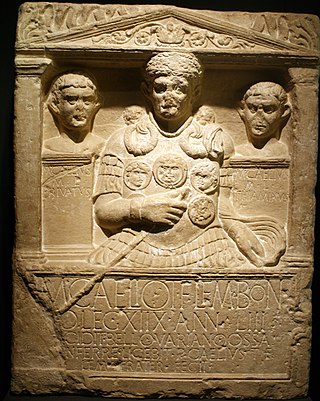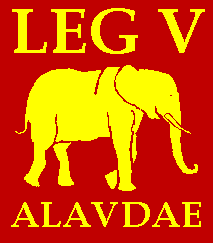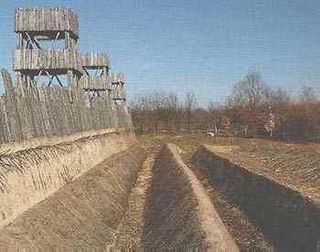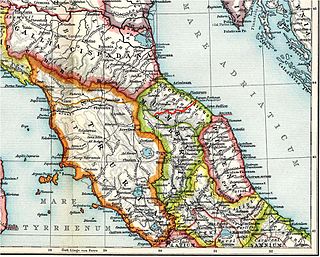
Vercingetorix was a Gallic king and chieftain of the Arverni tribe who united the Gauls in a failed revolt against Roman forces during the last phase of Julius Caesar's Gallic Wars. Despite having willingly surrendered to Caesar, he was executed in Rome.

The Battle of the Teutoburg Forest, described as the Varian Disaster by Roman historians, took place at modern Kalkriese from September 8–11, 9 AD, when an alliance of Germanic peoples ambushed Roman legions and their auxiliaries, led by Publius Quinctilius Varus. The alliance was led by Arminius, a Germanic officer of Varus's auxilia. Arminius had acquired Roman citizenship and had received a Roman military education, which enabled him to deceive the Roman commander methodically and anticipate the Roman army's tactical responses.

Commentarii de Bello Gallico, also Bellum Gallicum, is Julius Caesar's firsthand account of the Gallic Wars, written as a third-person narrative. In it Caesar describes the battles and intrigues that took place in the nine years he spent fighting the Celtic and Germanic peoples in Gaul that opposed Roman conquest.

The Gallic Wars were waged between 58 and 50 BC by the Roman general Julius Caesar against the peoples of Gaul. Gallic, Germanic, and British tribes fought to defend their homelands against an aggressive Roman campaign. The Wars culminated in the decisive Battle of Alesia in 52 BC, in which a complete Roman victory resulted in the expansion of the Roman Republic over the whole of Gaul. Though the Gallic military was as strong as the Romans, the Gallic tribes' internal divisions eased victory for Caesar. Gallic chieftain Vercingetorix's attempt to unite the Gauls under a single banner came too late. Caesar portrayed the invasion as being a preemptive and defensive action, but historians agree that he fought the Wars primarily to boost his political career and to pay off his debts. Still, Gaul was of significant military importance to the Romans. Native tribes in the region, both Gallic and Germanic, had attacked Rome several times. Conquering Gaul allowed Rome to secure the natural border of the river Rhine.
Titus Labienus was a high-ranking military officer in the late Roman Republic. He served as tribune of the Plebs in 63 BC. Although mostly remembered as one of Julius Caesar's best lieutenants in Gaul and is mentioned frequently in the accounts of his military campaigns, Labienus chose to oppose him during the Civil War and was killed at Munda. He was the father of Quintus Labienus.

Legio V Alaudae, sometimes also known as Gallica, was a legion of the Roman army founded in 52 BC by the general Gaius Julius Caesar. It was levied in Transalpine Gaul to fight the armies of Vercingetorix, and was the first Roman legion to comprise non-citizens. Historians disagree whether the legion was destroyed during the Batavian rebellion in AD 70, or during the First Battle of Tapae.

Legio X Equestris, a Roman legion, was levied by Julius Caesar in 61 BC when he was the Governor of Hispania Ulterior. The Tenth was the first legion levied personally by Caesar and was consistently his most trusted. Legio X was famous in its day and throughout history, because of its portrayal in Caesar's Commentaries and the prominent role the Tenth played in his Gallic campaigns. Its soldiers were discharged in 45 BC. Its remnants were reconstituted, fought for Mark Antony and Octavian, disbanded, and later merged into X Gemina.

Legio XIII Gemina, in English the 13th Twin Legion was a legion of the Imperial Roman army. It was one of Julius Caesar's key units in Gaul and in the civil war, and was the legion with which he crossed the Rubicon in January, perhaps the 10th, 49 BC. The legion appears to have still been in existence in the 5th century AD. Its symbol was the lion.

The Arverni were a Gallic people dwelling in the modern Auvergne region during the Iron Age and the Roman period. They were one of the most powerful tribes of ancient Gaul, contesting primacy over the region with the neighbouring Aedui.
Decimus Junius Brutus Albinus was a Roman general and politician of the late republican period and one of the leading instigators of Julius Caesar's assassination. He had previously been an important supporter of Caesar in the Gallic Wars and in the civil war against Pompey. Decimus Brutus is often confused with his distant cousin and fellow conspirator, Marcus Junius Brutus.

The Battle of Alesia or Siege of Alesia was the climactic military engagement of the Gallic Wars, fought around the Gallic oppidum of Alesia in modern France, a major centre of the Mandubii tribe. It was fought by the Roman army of Julius Caesar against a confederation of Gallic tribes united under the leadership of Vercingetorix of the Arverni. It was the last major engagement between Gauls and Romans, and is considered one of Caesar's greatest military achievements and a classic example of siege warfare and investment; the Roman army built dual lines of fortifications – an inner wall to keep the besieged Gauls in, and an outer wall to keep the Gallic relief force out. The Battle of Alesia marked the end of Gallic independence in the modern day territory of France and Belgium.

The Battle of the Sabis, also known as the Battle of the Sambre or the Battle against the Nervians, was fought in 57 BC near modern Saulzoir in Northern France, between Caesar's legions and an association of Belgae tribes, principally the Nervii. Julius Caesar, commanding the Roman forces, was surprised and nearly defeated. According to Caesar's report, a combination of determined defence, skilled generalship, and the timely arrival of reinforcements allowed the Romans to turn a strategic defeat into a tactical victory. Few primary sources describe the battle in detail, with most information coming from Caesar's own report on the battle from his book, Commentarii de Bello Gallico. Little is therefore known about the Nervii perspective on the battle.
The Battle of Gergovia took place in 52 BC in Gaul at Gergovia, the chief oppidum of the Arverni. The battle was fought between a Roman Republican army, led by proconsul Julius Caesar, and Gallic forces led by Vercingetorix, who was also the Arverni chieftain. The Romans attempted to besiege Gergovia, but miscommunication ruined the Roman plan. The Gallic cavalry counterattacked the confused Romans and sent them to flight, winning the battle.

Roman Gaul refers to Gaul under provincial rule in the Roman Empire from the 1st century BC to the 5th century AD.
Quintus Titurius Sabinus was one of Caesar's legates during the Gallic Wars. He is first mentioned in Caesar's campaign against the Remi, in 57 BC. In 56 BC, he was sent by Caesar with three legions against the Venelli, Curiosolitae, and Lexovii, who were led by Viridovix. He gained a great victory over Viridovix's forces, and all the insurgent states submitted to his authority.
The Lexovii, were a Gallic tribe dwelling immediately west of the mouth of the Seine, around present-day Lisieux, during the Iron Age and the Roman period.

The Coriosolites or Curiosolitae were a Gallic people dwelling on the northern coast of present-day Brittany during the Iron Age and the Roman period.
The Venellī or Unellī were a Gallic tribe dwelling on the Cotentin peninsula, in the northwest of modern Normandy, during the Iron Age and the Roman period.

The military campaigns of Julius Caesar constituted both the Gallic Wars and Caesar's civil war. The Gallic War mainly took place in what is now France. In 55 and 54 BC, he invaded Britain, although he made little headway. The Gallic War ended with complete Roman victory at the Battle of Alesia. This was followed by the civil war, during which time Caesar chased his rivals to Greece, decisively defeating them there. He then went to Egypt, where he defeated the Egyptian pharaoh and put Cleopatra on the throne. He then finished off his Roman opponents in Africa and Hispania. Once his campaigns were over, he served as Roman dictator until his assassination on 15 March 44 BC. These wars were critically important in the transition of the Roman Republic into the Roman Empire.

The Battle of Silva Litana was an ambush that took place in a forest 75 miles northwest of the Roman city of Ariminum during the Second Punic War in 216 BC. The Gallic Boii surprised and destroyed a Roman army of 25,000 men under the consul-elect Lucius Postumius Albinus and destroyed the Roman army, with only ten men surviving the ambush, a few prisoners were taken by the Gauls and Postumius was killed, his corpse was decapitated and his skull was covered with gold and used as a ceremonial cup by the Boii. News of this military disaster, reaching Rome probably after the election of consuls for 215 BC in Spring 215 BC or after the defeat at Cannae in the fall of 216 BC, triggered a renewed panic in Rome and forced the Romans to postpone military operations against the Gauls until the conclusion of the Second Punic War. Rome decided to focus on defeating Hannibal and sent only two legions to guard against any possible Gallic attack, however, the Boii and Insubres did not attack the Romans to exploit their victory. Cisalpine Gaul remained in relative peace until 207 BC, when Hasdrubal Barca arrived in Cisapline Gaul with his army from Spain.














